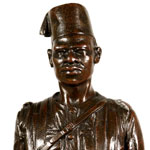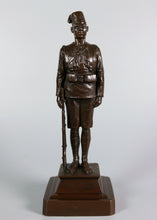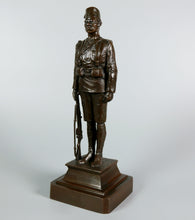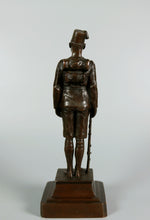The King’s African Rifles - A Bronze Figure of a First World War Askari, 1918
SOLD
Tax included.
Adding product to your cart
Bronze. Standing figure of a barefooted Askari in the Field Service uniform of collarless khaki shirt, shorts, puttees and fez.
Raised in 1902, the full strength of the King’s African Rifles in 1914 was 70 British officers, three British NCOs, and 2,325 Africans. By the end of the war this had expanded to 1,193 British officers, 1,497 British N.C.Os and 30,658 Africans in 22 battalions, including two made up of former German askaris. Throughout the period the K.A.R. continued its operations in Somaliland against Seyed Mohamed Abdullahi Hassan, the ‘Mad Mullah’ whose revolt threatened the stability of the whole Somali region, between 1900 and 1920.
Read more
The 1914-18 War was fought in German East Africa, now Tanzania, and the enemy did not lay down their arms until November, 1918. By the end of the war the K.A.R. strength had risen to 22 Battalions. This included a 6 K.A.R. raised from the ex-German askari of the Schutztruppen. Interestingly in 1964 the West German Government decided to address the pensions owed to 350 surviving former Schutztruppen for their services during the First World War. As none had any documentary proof of service, a test was devised whereby old soldiers proved their credentials by performing rifle drill as per the German manual of the 1914. Not a single applicant failed the test. K.A.R. casualties in the First World War were 5,117 officers and men killed and wounded with another 3,039 dying from diseases. Regimental Colours were awarded to the four senior K.A.R. Battalions in 1923.
Use left/right arrows to navigate the slideshow or swipe left/right if using a mobile device








